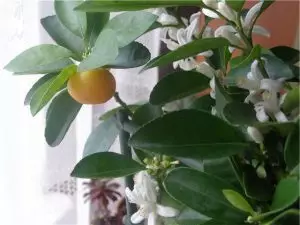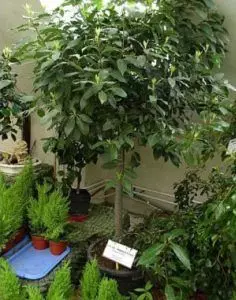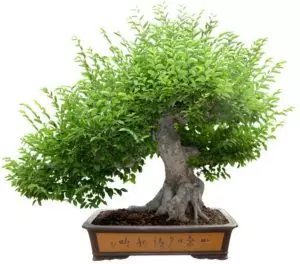With the onset of winter, most of the balcony plants dies, because Annual blooming cultures are not adapted to the cold. A single room plant can be overwhelmed on an open balcony, but in closed logs, you can grow some flowers adapted to low temperatures.
Winter balcony
Cultures for insulated balconies should be selected based on the climatic conditions of the area of residence and the conditions of the plant itself. The view that the room plants do not tolerate the temperature from 0 to + 5c is not true in the root. There are a number of indoor, which is simply necessary in winter according to the requirements of agrotechnology.
Desert cacti - brave spiny "hedgehogs" are not afraid of low temperatures, on the contrary - for violent flowering, cactus simply need a winter peace period at a relatively low temperature. Glazed and insulated balcony - an ideal place to winter cacti.

On the warmed balcony citrus felt much better than indoors
It is very important in the cold period to reduce watering as much as possible, and lay a collection in a sunny place. After properly organized wintering, cacti will show all the magnificence during the flowering period.
Citrus plants are perfectly winter at a temperature of + 7 °, making temporary temperature fluctuations up to 0. Natural habitat of citrus fruits is a Mediterranean, where oranges and lemons grow on the streets of cities. On the balcony, lemon trees are perfectly adapted to a reduced temperature, it is important to ensure that watering at that time was not abundant.
For citrus crops, wintering on the balcony is the best way out, because the plants tremendously feel in a dark room when the central heating is turned on. Dry air is contraindicated with orange and lemon bushes, because at elevated dryness of air on the plants, pests are attacked: the shield, a web tick and others.
Article on the topic: Paul from plywood: on guys with their own hands, the thickness of the laying in the apartment, the distance between the lags, which is used

The laurel tree without problems will transfer wintering on the balcony
Decorative and deciduous plants, such as a laurel tree, brushes, holly, palm trees, can carry wintering at temperatures from + 5c. If the loggia is reliably insulated, such a temperature is just supported in the room, but when frost is enhanced, it is necessary to carefully monitor the change in the temperature regime in order to put plants in heat in time.
Blooming houses are not at all silent, as they are considered to think about them. On the winter balcony, plants such as fuchsia, pelargonium, hydranshia (hydrangea) are perfect and bloom; Chrysanthemums and indoor roses.
The temperature range from +5 to +6 is just suitable for growing these plants on the winter balcony. It takes such a temperature and camellia, her amazing lush flowers challenge a cracker frost behind balcony windows.
For the flowering of Camellia, the pot position is very important relative to the source of light, so when buds appear, moving the pot with a plant is categorically not recommended.
Roughs for balcony

Juniper is a stylish balcony decoration
A separate conversation deserves a large group of conifers, which are often used to decorate winter balconies.
Most conifers perfectly tolerate wintering at temperatures from +6 to +10 degrees, so on the insulated loggia, the thui, juniper, ate, pines, cedars, cypresses, araucaria and other conifers feel perfectly.
How to grow Tyu
Thuja on the balcony in winter is grown most often. This culture is very easily spawned from the seed, so it is not very difficult to grow a lot of things. For growing in pots, the following types of Tui Western with a different form of the crown are suitable:
- "Danica" - this Tui variety is characterized by slow growth, the adult plant reaches a height of 1m. For balconies and loggias, it is very important that the tree does not grow to significant sizes, otherwise it will have to land it into open ground.
- The "TEDDY" variety - refers to dwarf varieties whose height does not exceed half a meter. Crown is formed with a haircut, usually give the trees a ball shape.
- "RECURVA NANA" - reaches a height of up to 1.5 m, but the plant develops very slowly. In the young age, Krone Tui has a spherical shape, a little later - pulls out, forming a cone-shaped form.
Article on the topic: Balcony in a wooden house with their own hands (photo)
Watch the video, how to properly care for the Tuya with your own hands.
In addition to green forms, there are Tui varieties with multicolored coloring needles. It is worth noting that the best tree is developing on a sunny balcony, the lack of light negatively affects the appearance of the tree - the thua is pulled out, the painting of the needles is pale. Especially demanding of the lighting of the Tui variety with colored cheese.
If the balcony is focused on the north side, besides glazed, it is best to refuse to grow. On the north side, the samshes are growing perfectly, which do not require bright lighting.
For coniferous, placed in pots and containers, there are two troubles: overflow and driving. In summer, robbery is needed regularly, spraying a temper several times a day. In winter, it is important to observe the measure when watering plants. In the cold time, the wet excavation combs long, so watering mode is installed special for winter time.
Coniferous plants in winter do not cease to grow, so they do not stop disappearing to fertilize the growing trees. In order to prevent the overdose of fertilizers in winter, you should use a granular fertilizer for coniferous prolonged validity period.
We recommend watching the video, how to carefully care for the thay.
To prevent the freezing of the root system of the Tui, the pots with plants should be thoroughly insulated, for which the containers with plants from all sides are covered with straw or cartotic mats, foam and other insulation materials.
